Our 7 am boat ride from Isla Santa Cruz where we'd been staying for the last four nights over to Isla Isabela was
one from h***; there’s no other way to put it. We arrived at the pier before
6:30 knowing our bags had to undergo an agricultural inspection first.
First, we had to take a boat taxi out to our boat and wait while everyone’s bags were put on board.
Steven somehow didn't manage to be on the same water taxi as I but it didn't matter as we met up again in a few minutes.
There was a full load of 21 people, some of whom had opted to clamber up top and sit by the captain. We were lucky enough to snag two seats on the outside of the boat rather than the very confining and claustrophobic interior.
The seats didn’t matter much as it turned out because the
boat developed engine trouble right away and we didn’t move. Those tourists
lucky enough or smart enough to book with other boats left on time and, we heard
later, had no problems with the crossing. We weren’t so lucky this time and
everyone on our boat had to wait around while a mechanic was brought by taxi
boat to see if he could work his magic on the engine. About 90 minutes later,
he gave up the fight and everyone was transferred to another boat which made the
crossing.
I think we must have been jinxed that day because the new boat’s engine began sputtering halfway across the 2.5 hour trip when we were in the middle of nowhere AND no mechanic to call on either this time.
After another boat taxi to the dock, we heaved a huge sigh of relief once we finally set foot on terra firma once again. Normally, there's a port tax upon arriving at Isabela but the authorities smartly waived it knowing of our difficult crossing!
The sight of the sea lions cavorting on the sunny pier
boosted our sagging spirits.
A pelican atop the pier:
We had to step over sea lions on the path past the dock and make sure not to hit them with our bags!
The prospect of lugging our bags a kilometer or more to our hotel didn’t enthrall us as the hotel had given up on us when we didn’t show 2.5 hours earlier, not surprisingly. They ‘rescued us’ though by sending out a pickup truck to fetch us as there were few cars and no taxis as such on the island, only enterprising men who used their trucks as taxis.
We quickly left our things in our room and headed out to
explore as we still had the afternoon left. Because I/we do so much advance
planning for all of our trips, we always know what we ‘can’ do if we want
immediately upon landing in a new place.
Our reason for spending hundreds and hundreds of hours at the very least for months in advance is to make it easy on ourselves knowing what we likely want to see and do when we hit a new place. That pre-planning works so much better for us than to spend time on arrival figuring out what there is to discover and how to get to each of those places. We walked toward the Giant Tortoise Breeding Center on the island.
We had known to look out for the very aptly named Iguana Crossing Hotel. You'll see why in the next photo!
The only stop sign on the island is at the iguana crossing where the iguanas make their way from the sea inland. Even the police officers stop there!
The trail to the Center took us through some fantastic scenery and
very close access to some more iguanas!
Any bird lover know what this spindly-legged bird this was we saw in the small lagoon?
We were both surprised that the back of the Iguana Crossing Hotel had no balconies looking over the lagoon.
The next section of the trail was called 'The Jelly Door Pond.'
The sight of the flamingos a little further on was absolutely spectacular.
I SO hope you won't be sick of seeing these magnificent animals after looking at these photos because we have seen hundreds and hundreds of flamingos in southern Bolivia in the last few days, just a few today and will be seeing even more of them here in northern Chile tomorrow. At least I won't have time to write those posts for a few weeks so you can hopefully enjoy seeing more then!
We were both spellbound by our first sight of them. I think Steven is far less so now, however!
I was so surprised at how pale the flamingos were. Perhaps I was remembering the gaudy pink flamingos that decorate some people's lawns!
The first one we’d ever seen swimming:
Balthazar Pond was coming up next.
What a change going from the marshland into the forest. This looked like such an idyllic resting spot on our way to the Giant Tortoise Breeding Center.
It was remarkable we had had virtually the trail to ourselves.
A sign announced that construction of the center was made possible thanks to UNESCO, WWF, USAID and foreign agencies.
The baby tortoises were in different pens just as they had
been at the Charles Darwin Research Center on Santa Cruz Island.
We were drawn immediately to the giant tortoises as we had also been before. It must have been 'siesta time' as we didn't see many of the huge animals move at all.
We saw some juvenile giant tortoises that came from Sierra Negra Volcano, located on another part of the island. Very few giant tortoises live under natural conditions there so the juveniles will, in a few years, begin breeding to recover the wild part of Isla Isabela.
Number 12, the tortoise in the foreground, and number 50 fought for a good while until
finally number 50 retreated after being bit by number 12 who then went after
others! It was like we were watching an episode of Wild Animal Kingdom!
Don't forget you can enlarge any of the photos by simply clicking on any one.The baby pens:
Although this population of giant tortoises belongs to the species found on Sierra Negra Volcano, only a few were found on the slopes in a place called Five Hills. The shell of this species is squashed down, unlike any other tortoise living in the Galapagos.
18 adults have been living at this breeding center since 1998 when they were rescued from an erupting volcano. Fortunately all the males are sexually active and the females are quite active, so, just two years after bringing them to the center, there were already over 200 baby tortoises!
We noticed plastic containers everywhere to trap wasps and
had remembered seeing them at Las Grietas, the water tunnels on Santa Cruz.
We toured the small but decent museum next. There we learned that although juvenile tortoises look alike, male adults are bigger than female adults.
We discovered that giant tortoises make their nests in dry zones with enough earth to dig a nest and the right temperature for incubating their eggs. With great effort, they dig a hole with their hind feet and deposit between 6 and 14 eggs. Then they urinate and defecate to moisten the ground and cover the eggs. Finally they leave the nest.The little tortoises hatch from their eggs in about 160 days. The newborns must scrape away the hardened earth of the nest for about 30 days before they reach the surface. This job goes more quickly when many siblings cooperate! The newborns have nothing to eat or drink while inside the nests but survive thanks to food reserves inside their bodies.
Once out of the nest, baby tortoises face a difficult life as they must survive on their own. Currently, because almost no tortoise born in the wild can survive, one of the breeding centers in the Galapagos must care for the egg and help the baby tortoise.
Staff and volunteers bring eggs for incubation from nests in the field as well as from nests made by tortoises at the Breeding Center. Each egg must be carried in the same position as it was found as otherwise the embryo may die.
I cringed when I saw this image of an 85-year old man with one step in the grave! The little tortoises by contrast will need at least a century before they become really large.
The tortoise at a comparable age looked alive and kicking, so to speak! Perhaps he wouldn't be so youthful at the ripe old age of 150 when tortoises have reached their expected lifespan either!
After spending a couple of intriguing hours at the Center, we left around 2ish and retraced our steps along the boardwalk, hoping to see some more flamingos as we were more than a tad besotted by their beautiful shading and dainty movements!
We were in luck as you can see!
Although it was a stretch to call iguanas cute, this baby one qualified in my opinion!
We came so, so close to stepping on this iguana as we weren't paying attention while strolling along the boardwalk. I hate to think how he or she might have responded!
As this post is already long enough, I will leave the rest of our day to the next one.
Next post: Hiking to the Wall of Tears immediately afterwards!
Posted on November 20th, 2017, from San Pedro de Atacama in northern Chile.


















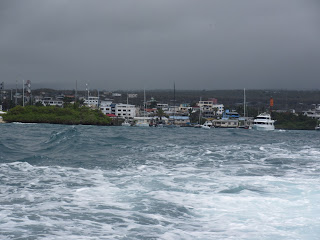

























































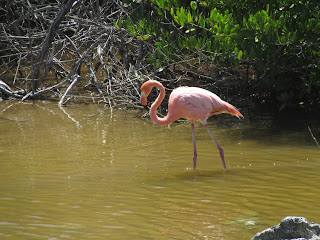

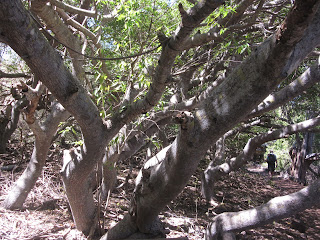













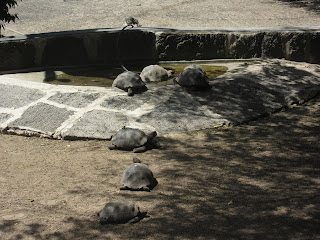






















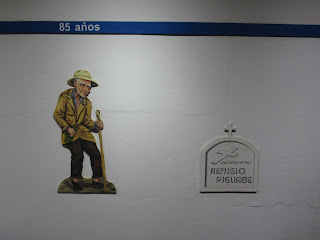





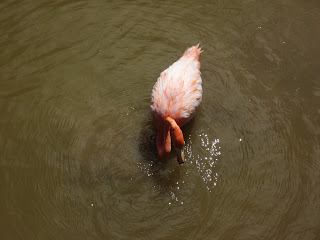









I NEVER tire of seeing photos of the amazing creatures that call the Galapagos their home. What fabulous fun despite the initial mechanical issues with your boat.
ReplyDeleteENJOY the island life and all its four legged residents. xo Lina